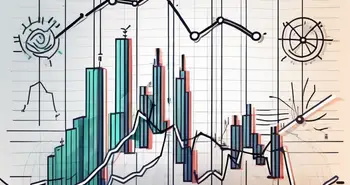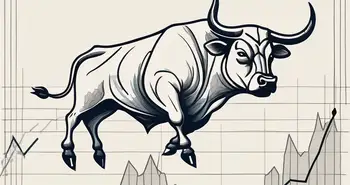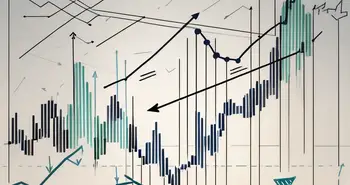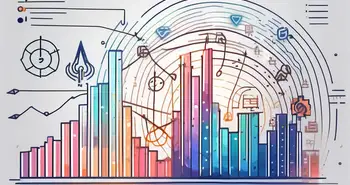The Intricacies of Trend Lines Pattern

Trend lines are a fundamental tool in technical analysis that can help traders and investors make informed decisions in the financial markets. In this comprehensive guide, I will walk you through the intricacies of trend lines and provide you with the knowledge and skills needed to effectively use them in your trading strategies.
Understanding the Basics of Trend Lines
Before diving into the details, let's start with the definition and importance of trend lines. A trend line is a straight line that connects two or more significant price points on a chart, representing the direction and slope of the underlying trend. It acts as a visual aid to identify and confirm trends, whether they are upward, downward, or sideways.
But what makes trend lines so powerful? Well, they provide traders and investors with valuable insights into market dynamics. By drawing a trend line, you can gain a better understanding of the overall trend and potential future price movements. This can help you make informed decisions when it comes to buying or selling assets.
When it comes to trend lines, there are different types you need to be aware of. The most common ones include uptrend lines, which connect higher swing lows, and downtrend lines, which connect lower swing highs. These lines can give you a clear indication of the direction in which the market is moving.
But what about horizontal trend lines? These lines represent a period of consolidation or a range-bound market. In other words, when the price of an asset moves within a certain range, without showing a clear upward or downward trend, it is said to be in a consolidation phase. During this time, horizontal trend lines can be drawn to connect the upper and lower boundaries of the range, providing traders with potential support and resistance levels.
By understanding the different types of trend lines, you can enhance your technical analysis skills and improve your ability to identify profitable trading opportunities. Whether you are a beginner or an experienced trader, incorporating trend lines into your analysis can be a valuable tool in your trading arsenal.
The Science Behind Trend Lines Pattern
Behind the simplicity of trend lines lies a scientific approach to analyzing market data. Statistics play a crucial role in determining the reliability and significance of a trend line. By calculating the slope and the correlation coefficient, traders can evaluate the strength and the direction of a trend.
The mathematical perspective of trend lines brings even more insight into their patterns. By applying tools such as regression analysis and moving averages, traders can generate more accurate trend lines that filter out short-term fluctuations and provide a clearer picture of the overall trend.
Let's delve deeper into the statistical methods used in analyzing trend lines. One important aspect is calculating the slope, which measures the steepness of the trend line. A positive slope indicates an upward trend, while a negative slope signifies a downward trend. Traders use this information to determine the potential profitability of an investment.
Another statistical measure that traders rely on is the correlation coefficient. This value ranges from -1 to 1 and indicates the strength and direction of the relationship between two variables. In the context of trend lines, the correlation coefficient helps traders determine how closely the data points align with the trend line. A high correlation coefficient suggests a strong relationship, increasing the confidence in the trend line's accuracy.
Now, let's explore the mathematical tools that enhance the accuracy of trend lines. Regression analysis is a powerful technique that helps traders identify the relationship between the dependent variable (such as stock prices) and one or more independent variables (such as time). By fitting a regression line to the data, traders can estimate future values and make informed decisions based on the trend line's projection.
Moving averages are another valuable tool in trend line analysis. They smooth out short-term fluctuations by calculating the average price over a specific period. This helps traders identify the underlying trend amidst market noise, providing a clearer picture of the overall direction. By incorporating moving averages into trend line analysis, traders can make more accurate predictions and improve their trading strategies.
Reading and Interpreting Trend Lines
To become proficient in using trend lines, it's essential to know how to interpret them. One vital skill is identifying upward and downward trends. An upward trend is characterized by higher swing lows and higher swing highs, suggesting a bullish market sentiment. Conversely, a downward trend exhibits lower swing highs and lower swing lows, indicating a bearish market sentiment.
In addition to upward and downward trends, recognizing sideways or horizontal trends is equally important. These trends occur when the price moves within a range and fails to establish a clear direction. As a trader, it is crucial to identify these periods of consolidation to avoid false signals.
The Art of Drawing Trend Lines
When it comes to drawing trend lines, utilizing the right tools is paramount. Most trading platforms offer a variety of drawing tools, including trend lines. These tools can help you accurately plot trend lines on your charts without any hassle.
To draw accurate trend lines, you should follow some best practices. Start by identifying the most significant swing lows and swing highs, ensuring that the trend line connects at least two of these points. Avoid fitting the trend line to accommodate minor price fluctuations, as this could result in false signals. Remember, the key is to capture the essence of the trend.
Advanced Concepts in Trend Lines Pattern
As you become more proficient in using trend lines, you may be interested in exploring advanced concepts. One such concept is the idea of channels within trend lines. Channels are formed when two parallel trend lines enclose price movement, providing traders with a visual representation of support and resistance levels.
Another fascinating aspect is the relationship between trend lines and market reversals. In some cases, trend lines can act as a predictive tool, signaling a potential trend reversal. By observing how price interacts with a trend line, traders can anticipate when the current trend might be reaching its end and prepare to adjust their trading strategies accordingly.
Throughout my years of experience in trading, I have witnessed the power of trend lines firsthand. They have guided me through countless market situations and provided me with valuable insights. One piece of advice I can offer is to always combine trend lines with other technical analysis tools and indicators for a more comprehensive view. Remember, no single tool should dictate your entire trading strategy.
FAQ
Q: What is the purpose of trend lines?
A: Trend lines are used to identify and confirm trends in the financial markets. They help traders and investors make informed decisions by visually representing the direction and slope of price movements.
Q: How do I draw an accurate trend line?
A: To draw an accurate trend line, start by identifying significant swing lows and swing highs. Connect at least two of these points using a straight line without accommodating minor price fluctuations.
Q: Can trend lines predict market reversals?
A: While trend lines can act as a predictive tool, they should not be solely relied upon for predicting market reversals. It is essential to combine trend lines with other technical analysis tools and indicators for a more comprehensive analysis.
Q: Are trend lines applicable to all financial markets?
A: Yes, trend lines can be applied to various financial markets, including stocks, forex, commodities, and cryptocurrencies. The principles behind trend lines remain consistent regardless of the market.
Q: How often should trend lines be updated?
A: Trend lines should be regularly re-evaluated and updated to reflect the latest price movements. As new swing lows and swing highs are formed, it is necessary to adjust the trend lines accordingly.
By mastering the intricacies of trend lines, you can gain a valuable edge in the financial markets. Remember to practice drawing accurate trend lines and combine them with other technical analysis tools for a well-rounded trading strategy. With time and experience, you will develop a keen eye for spotting trends and making informed trading decisions.
Ready to put your newfound knowledge of trend lines into practice? Look no further than Morpher, the revolutionary trading platform that's changing the game with blockchain technology. Whether you're interested in stocks, cryptocurrencies, forex, or even niche markets like NFTs and luxury goods, Morpher offers a seamless, zero-fee trading experience with infinite liquidity. Embrace the flexibility of fractional investing, the convenience of short selling without interest fees, and the security of a non-custodial wallet. Plus, with up to 10x leverage, you can take your trading strategies to the next level. Experience the future of trading with Morpher's unique Virtual Futures on the Ethereum Blockchain. Sign Up and Get Your Free Sign Up Bonus today, and join the global community of traders who are already navigating the markets with precision and confidence.

Disclaimer: All investments involve risk, and the past performance of a security, industry, sector, market, financial product, trading strategy, or individual’s trading does not guarantee future results or returns. Investors are fully responsible for any investment decisions they make. Such decisions should be based solely on an evaluation of their financial circumstances, investment objectives, risk tolerance, and liquidity needs. This post does not constitute investment advice.

Painless trading for everyone
Hundreds of markets all in one place - Apple, Bitcoin, Gold, Watches, NFTs, Sneakers and so much more.

Painless trading for everyone
Hundreds of markets all in one place - Apple, Bitcoin, Gold, Watches, NFTs, Sneakers and so much more.








